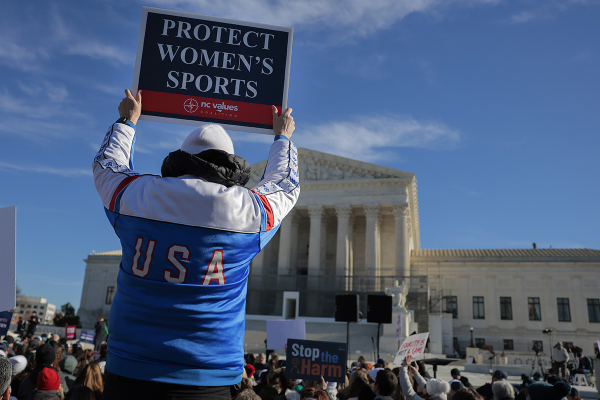Trump Has Science on His Side in Birth Control Debate

Its many critics fail to persuade. The Trump administration's decision to respect the conscience rights of employers who do not wish to include contraceptives or abortion-inducing drugs in their insurance plans has generated a firestorm of controversy. The principle of religious freedom has been criticized, and the research behind this decision has been sharply, albeit unpersuasively, attacked.
My 2015 Ave Maria Law Review article on the impact of state contraceptive mandates was one of the studies the administration cited in its rule. Allow me to correct the record.
Some criticisms are not even worth responding to at length. Writing for The New York Times, for example, Linda Greenhouse simply dismisses studies questioning the efficacy of contraception programs as "dubious." Similarly, the online publication Vox boldly argues that 1) contraception programs are effective and 2) expanding birth control has not encouraged risky sex. These two arguments are backed up by precisely one study each — hardly a thorough review of the academic literature.
The most substantive and comprehensive criticism of the policy comes from Aaron Carroll, a professor of pediatrics at Indiana University School of Medicine. In an October 10 New York Times article, he states that the Trump administration's claims about contraception "do not stand up to scrutiny." To his credit, Carroll's analysis of contraception and pregnancy data is more thorough than that of other Trump-administration critics. That said, Carroll is guilty of the very practices of which he accuses others — namely, cherry-picking studies and analyzing data from unnecessarily short time frames.
For example, Carroll dismisses the administration's statistics showing increases in both contraception use and unintended pregnancies between 1972 and 2002. He states that in 2011 the unintended pregnancy rate hit a 30-year low, and — without presenting any data or studies to support his argument — credits contraception.
But this doesn't begin to explain away the fact that for decades exploding contraceptive use occurred alongside rising or stagnant unintended-pregnancy rates. Even in the later period of 1981 to 2008, contraception use rose substantially while the unintended-pregnancy rate fell only slightly, from 59 to 54 per 1,000 women of childbearing age.
Unsurprisingly, Carroll is quick to credit increases in contraception use for the sharp decline in the teen-pregnancy rate as well. In fairness, there is some evidence that sexually active teenagers have become more likely to use contraception. Furthermore, to his credit, Carroll cites some statistics indicating a decline in teen sexual activity, a rival explanation for the declining pregnancy rate. However, the statistics Carroll presents about teen sexual activity are from a narrow time frame — giving the impression that the change was only marginal.
In reality, teen sexual activity has been consistently declining since the early 1990s. According to the National Survey of Family Growth, between 1988 and 2015, the percentage of teen boys who'd ever had sex fell from 60 percent to 42 percent. During the same time frame, the percentage of teen girls who'd ever had sex fell from 51 percent to 42 percent.
Carroll also cites the Contraceptive CHOICE project as evidence of the efficacy of contraception programs. Researchers gave 9,000 women in St. Louis long-acting reversible contraceptives (LARCs) and found declines in the unintended-pregnancy rate. However, there is less here than meets the eye. This study did not include a control group. Furthermore, LARCs are used by a small percentage of women and have a high discontinuance rate. Therefore it is not clear that these findings are generalizable to the broader population.
In his article, Carroll conspicuously ignores research calling into question the efficacy of contraception programs. This summer in the Journal of Health Economics, British economists David Paton and Liam Wright analyzed recent funding cuts in teen sex-education and contraception programs in Great Britain. They found that areas with the largest funding cuts saw the largest decline in teen pregnancies. Similarly, in 2015, two University of Notre Dame economists published a study finding that 1990s high-school condom-distribution programs were correlated with increases in the teen pregnancy rate.
Overall, contrary to Carroll's claims, increases in contraception use have not always resulted in large reductions in the unintended-pregnancy rate. Good research by a number of economists, including Federal Reserve chairwoman Janet Yellen, shows that greater access to contraceptives often results in more sexual activity. Furthermore, a number of rigorous studies demonstrate that attempts to encourage contraception use through distribution programs, mandates, or subsidies have been ineffective at best and counterproductive at worst.
Interestingly, The New York Times has been very aggressive in its criticisms of the research behind the Trump administration's new contraceptive-coverage policy. This is ironic since the Times' own coverage of both abortion and contraception research has often been misleading. In 2006, The New York Times ran a front-page story claiming — based on a superficial analysis of state-level abortion data — that six recently passed pro-life parental-involvement laws were ineffective at lowering abortion rates among minors. The article all but ignored the 15 peer-reviewed studies in academic journals finding that parental-involvement laws reduce minors' abortion rates.
Furthermore, in 2016, New York Times columnist Gail Collins claimed that funding cuts to Planned Parenthood resulted in an increase in the unintended-pregnancy rate in Texas. However, Collins's source was GWU law professor Sara Rosenbaum, who had written a study that predicted an increase in the unintended-pregnancy rate but provided no data indicating that such an increase had actually occurred. When this was brought to the attention of Collins and Rosenbaum, neither took steps to correct the error.
Perhaps the Trump administration's research on contraception is more reliable than that of the administration's most visible and vocal critics. A full airing of the facts is in the public's interest.
Originally posted at National Review.





















